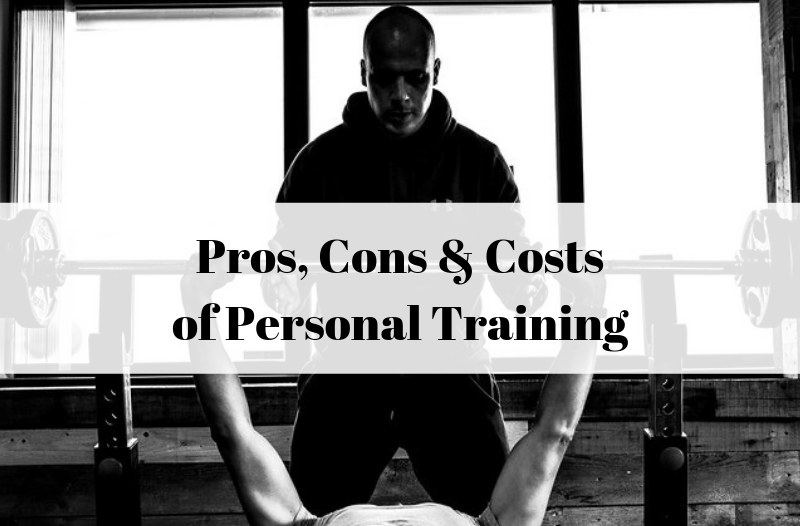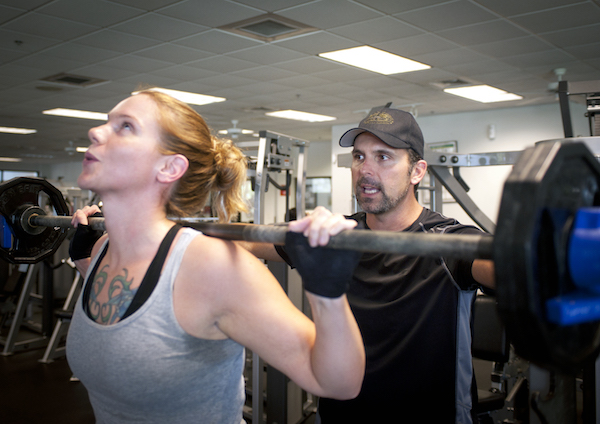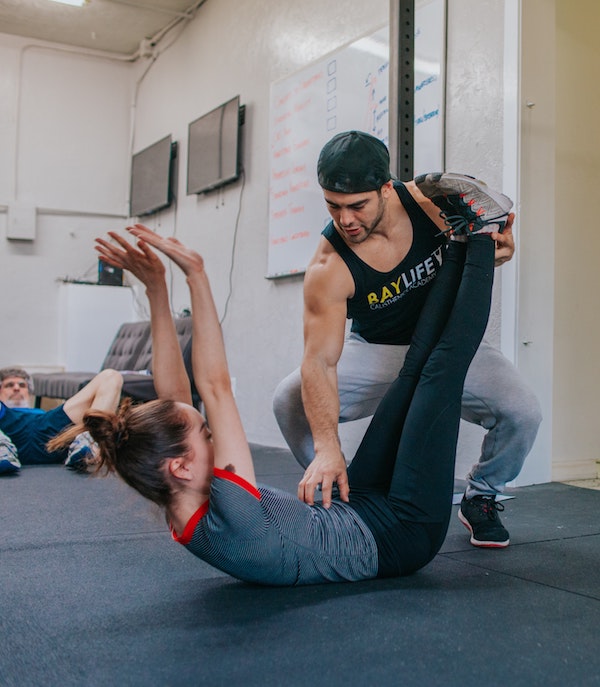
Getting started on a fitness regimen is hard work.
It’s confusing at first, it’s tough to get motivated, and there are so many choices and ways you can screw it up.
It’d be great if you could just hire a personal trainer to tell you what to do and when!
Well, if you’re willing to cough up the dough, you can. Walk into any big box gym, or hit up the Internet, and you can find someone to do exactly that.
It’ll cost you a pretty penny, however.
Are personal trainers worth it? What are the pros and cons of hiring a personal trainer?
Overall, personal trainers are a wonderful way to develop accountability, motivation, and safe, effective workout habits.
However, they can be a little expensive and, if you’re not careful, your trainer can easily become a crutch.
Below, I’ll get into how much a personal trainer costs (and how to keep the price down) and how to get the absolute most value possible out of personal training.
How much do personal trainers cost? (Average per session, per hour, and per month rates explained)
According to Lessons.com, an hour-long session with a personal trainer can cost anywhere from $40-70, or a little bit less if you choose group training sessions.
Of course, this all depends on where and who you hire.
Personal training is often available at big box gyms like LA Fitness, Life Time, and Gold’s Gym, for example. You’ll likely pay around $60 per hour for training in-house at one of these locations.
You can also hire an outside personal trainer to consult with or bring to the gym with you, and those costs will vary depending on your location, the experience of the trainer, what services he or she provides, etc.
A common personal training schedule consists of 2 sessions per week.
That brings your total monthly personal training cost to (and again, this is a rough estimate based on national averages), $250 to $400 per month.
Remember, that’s likely going to be in ADDITION to your gym membership, which will usually run about $30-50 per month, depending on where you join.
You can also usually save some money on the per session or per hour cost by booking a block of sessions all at once, rather than paying as you go.
What to look for in a GOOD vs BAD personal trainer

Not all personal trainers are created equal.
“If you walk into a typical gym and buy a block of personal training sessions, chances are you will be taught poorly,” says Dan DeFigio, fitness and nutrition expert and owner of Basics and Beyond.
“You’ll probably end up with back problems or shoulder problems and have to learn proper exercise technique from someone better”
If you just need a little accountability to get going, he says, go for it. But if you want to really get the best personal trainer results possible, here’s what you need to look for in a trainer:
Certifications
Just like trainers themselves, not all personal training certifications are created equal!
The title “personal trainer” can mean almost anything. You should find out what it ACTUALLY means before you start booking classes with someone.
“Trainers have varying levels of education, certifications and experise,” says Rachel Christy, a former AFAA certified personal trainer and Mad Dogg spin instructor.
“Certifications can range from a $70 online certification to a BS degree in athletic training.”
According to Melissa Morris, an ACSM certified exercise physiologist and writer at Exercise.com:
“The most reputable certified personal trainer certifications come from ACSM (American College of Sports Medicine), ACE (American Council on Exercise), NSCA (National Strength and Conditioning Association), NASM (National Academy of Sports Medicine), and ISSA (International Sports Sciences Association).
“If your personal trainer has a bachelor’s degree in exercise science, exercise physiology, or a related field, that’s even better!”
(Learn more about the different types of fitness instructors here.)
Previous client successes
“If you are hiring a contractor to build you a home, look at other homes they have built to ensure they can deliver the product you desire,” says Ronald Humes, a Certified Personal Fitness Trainer (PFT) through ACE and VP of Post Modern Marketing.
“The home you are looking to build is your body. ”
Ask if you can chat with former clients, or at least see some before and after photos.
You want to hear good references about what it’s like to work with that trainer, but you also want to see results. Were the clients successful in losing weight, building muscle, or developing a better physique?
If not, you should be cautious.
Their own health, fitness & physique
Personal trainers are real people outside of their job, and they’ll have their own goals, preferences, and challenges when it comes to health and fitness.
But they should at least represent a respectable level of fitness, and they should have a pretty good physique; something close to what you might want for yourself.
Otherwise, how can you trust that they actually know what they’re talking about?
You’d be surprised how often this is an issue. When I first joined up at a local box gym, the guy who offered me a fitness assessment and training was… how to put this delicately… NOT in good shape.
That was a hard pass for me, and it should be for you, too.
It sounds harsh, but it’s your money and your life. Spend it wisely.
Personality fit & vibe
It’s important that you and your trainer are a good “fit.”
Not just in terms of your goals and their expertise, but personality-wise.
Part of the benefit of working out with a trainer is that it should make the whole process more fun, engaging, and motivating vs going to the gym alone.
If you’re not clicking with a trainer, it doesn’t mean they’re bad at their job, it just means they may not be the right fit for you.
Professionalism
While it’s important to get along well with your trainer and have some fun while you’re working out together, at the end of the day, you’re not paying them to be your gym buddy or best friend.
They should be focused on the job at hand, giving you their 100% undivided attention.
You’d be amazed how often personal trainers are content to idly chat with other trainers or scroll mindlessly on their phone while their clients are performing exercises.
Look for a trainer who has a professional work ethic and will engage with you fully for the 30 minutes to an hour that you’re together.
How to get the most bang for your buck out of personal training
Hiring a personal trainer has a lot of value.
But it IS expensive; there’s no getting around that.
Here are a few pro tips on how to bring your costs down AND make sure you’re getting the absolute most out of your training time.
Try different trainers
There’s no shame in booking a session or two with a trainer and then moving on.
Sometimes you have to play the field a little bit before you commit!
It’s like it is with therapists. Sometimes it takes people a while to find a therapist that really gels with their personality, their specific problems, and even their schedule.
Personal trainers are the same.
One may be a great trainer, but they might not be the best fit for you.
Don’t be afraid to try out different options until you’re completely satisfied with how you’ll be spending your money.
Book sessions every 4-8 weeks
It might take a few weeks of more frequent sessions to “spin up,” and develop a rapport with your trainer.
They can get you started with a basic fitness assesment, some education, learning proper exericse form, and starting on a workout program.
From there, you might not need to continue seeing them twice per week.
Look for trainers who are willing to check in with you once every month or two.
For most people, that’s plenty. They can monitor your progress, correct form, tweak your program, and help you problem solve any challenges you’re having.
If you’re trying to keep costs down, you might not need them standing behind you every single workout.
Consider online personal training
These days, you don’t even have to pay for in-person training if you need a little guidance.
Online personal training can be super effective, and it’s a totally viable option.
“(Online) I can create individual programs for my clients to take with them to the gym and can even give feedback on their performance by monitoring the data they provide,” says Caitlin Motta, NASM certified trainer and owner at CoachCaitie.com.
“I can even have clients take video of themselves, so I can check in on their form. This seriously cuts down on cost and gives a little more scheduling flexibility for busy clients, but it still provides accountability and expertise.”
Have them teach you to not need them
If you literally can’t or don’t know how to workout WITHOUT your trainer, you (and they) are doing it wrong.
Along with weight loss, muscle gains, or athletic performance, one of your goals should be to learn some level of fitness independence.
A lot of trainers love to constantly touch you, support you, spot you, and correct in real-time. That way, it FEELS like they’re doing a lot and you’re getting a lot of value for your money.
But it’s important that they let you do things on your own, too.
You should learn how to bench press without them touching the bar, for example, or get in a HIIT workout without them calling out all the moves and pushing you.
If you want to keep the costs down, not needing to lean on a trainer forever and ever is a good way to do it.
Put in the work
“Trainers are not miracle workers and their time with you is limited. So it is important that you take advantage of your time with them,” says Christy.
It’s up to you to actually put in the effort required to get results.
“On the other hand,” she says, “if you are following your plan to the “T” and are still not meeting the milestones based on the plan your trainer has created it is worth a conversation with your trainer to hold him/her accountable and maybe time to move on.”
Overall pros of personal training

Accountability
This is probably the biggest benefit of hiring a trainer.
Once you pay them, you’re locked in.
You’ll be given a specific time to show up (that works with your schedule), and once you’re there, they’ll tell you exactly what to do.
All you have to do is make the time and put in the effort. Most of the rest of the decision making will be done for you!
Having this accountability is huge when you’re first starting out or struggling with motivation.
Entertainment & support
I like to work out alone, but it’s not for everyone.
It can get a little bit lonely, for sure, and you can sometimes be limited in what you can do without a spotter or partner to help.
Having a trainer can make working out a LOT more fun and engaging.
They can be there to celebrate your victories and help you through setbacks.
Safety & knowledge
When you start working out, it’s really, really important to learn how to do things properly and safely.
(Especially when it comes to lifting weights.)
Form and technique pointers from a certified expert in real-time can save you a LOT of problems down the road, from getting better, faster results to preventing injuries.
(Certified trainers will also be far better at accomodating any physical limitations you have or helping to rehab injuries, versus trying to figure it out on your own.)
Overall cons of personal training
Expensive
If you already pay for a gym membership and want to tack on a few personal training sessions per week, you could easily wind up spending $500 per month on your fitness.
For some, that’s a drop in the bucket.
For most of us, though, that’s a budget buster.
Refer to my tips above (less frequent sessions, online coaching, etc.) to get more bang for your buck.
Can become a crutch
If you ONLY workout when you have personal training, you’ll fall into the trap of never being able to workout without them.
It’s great to have support, form pointers, and encouragement in real-time.
But you’ll be better off in the longrun if you learn to live without it.
Bad trainers are more common than you think
Not all personal trainers are experts. Some simply got a certification online or over a weekend.
(Which doesn’t make them bad people or mean they’re not knowledgable, but in general, you should feel better about working with people who have more training and experience.)
Paying a ton of money for a trainer to put you through a cookie-cutter workout while he flips through his phone is a huge waste of cash, and could seriously hinder your workout progress.
Do your homework early on and find a trainer who knows what to do.
Cost-effective alternatives to personal training
If you just can’t stomach the cost of individualized personal training, don’t worry.
You still have some other options.
Online personal training
I mentioned this above, but it’s worth repeating here.
Whereas an in-person trainer will cost about $250-400 per month, online coaching will be substantially cheaper.
According to SELF, you can expect to pay about $100-200 for a 6-10 week custom workout program with check-ins and feedback from your online trainer.
That’s definitely a better deal, though you’ll lose out on in-person instruction.
Comprehensive workout & nutrition programs
You don’t need a trainer to build you a custom program to know what workout you should do every day.
You can buy a workout program online (or find a free one) and follow it to the T for some pretty excellent results.
Start with my list of the best workout programs for reviews and comparisons of my favorites like Kinobody, Beachbody, and more.
Group fitness classes
If it’s the group atmosphere and encouragement you like, try some group fitness studios like Orangetheory, Burn Boot Camp, Cyclebar, and more.
Sign up for a free month of ClassPass and hop around to a bunch of different studios nearby to see what you like.
Other fitness apps
You can keep on-demand workouts in your pocket and take them to the gym with you for just a few bucks per month.
Aaptiv features audio-guided workouts you can do at the gym, even on the treadmill or elliptical.
Beachbody on Demand and the Jillian Michaels app are awesome for at-home fitness, with complete programs you can follow and even nutrition plans.
These are great alternatives to investigate!
Wrapping Up
Are personal trainers worth it?
It depends on your budget and how good your trainer is.
You can get a lot of value out of personal training, including a safe way to learn proper exercise form, extra motivation and accountability for the gym, and customized feedback.
But for a lot of people, it won’t be feasible to hire a trainer twice a week for an extended period of time.
To keep the costs down, definitely consider less frequent sessions once you get going, or opt for an online program (whether it’s customized with a coach or one you buy and follow on your own).
Any more questions about personal training? Let me know in the comments!
And I hope this helped!